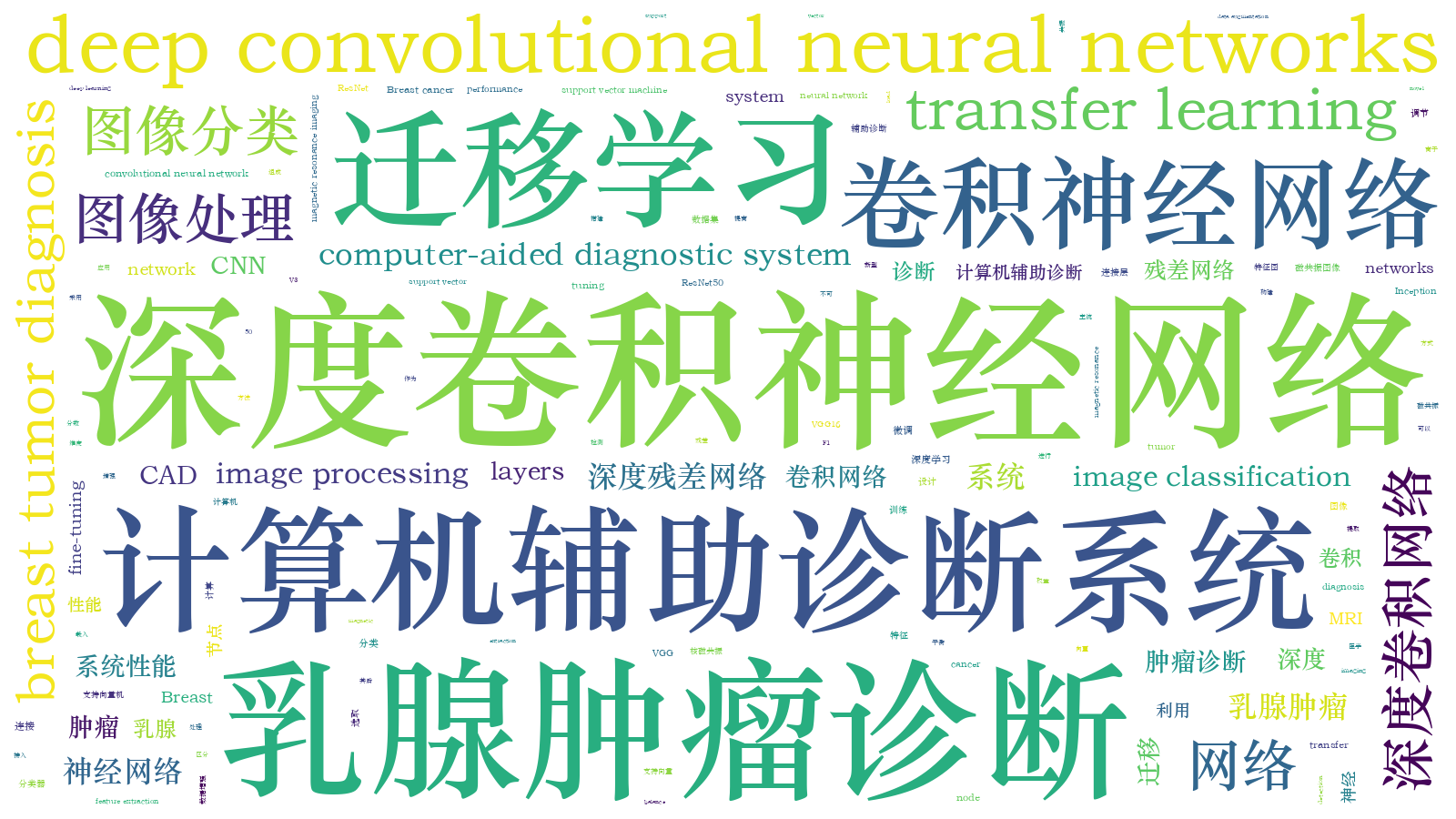基于迁移学习和深度卷积神经网络的乳腺肿瘤诊断系统  下载: 1503次
下载: 1503次
[1] Pei C D, Wang C M, Xu S Z. Segmentation of the breast region in mammograms using marker-controlled watershed transform[C]. The 2nd IEEE International Conference on Information Science and Engineering, 2010: 2371-2374.
[2] Ries L A G, Harkins D, Krapcho M, et al. SEER cancer statistics review, 1975-2003[R]. Bethesda: National Cancer Institute, 2006.
[3] Fenton J J, Taplin S H, Carney P A, et al. Influence of computer-aided detection on performance of screening mammography[J]. New England Journal of Medicine, 2007, 356(14): 1399-1409.
[4] Tang J, Rangayyan R M, Xu J, et al. Computer-aided detection and diagnosis of breast cancer with mammography: recent advances[J]. IEEE Transactions on Information Technology in Biomedicine, 2009, 13(2): 236-251.
[5] Litjens G, Kooi T, Bejnordi B E, et al. A survey on deep learning in medical image analysis[J]. Medical Image Analysis, 2017, 42: 60-88.
[6] Yoon S, Kim S. Mutual information-based SVM-RFE for diagnostic classification of digitized mammograms[J]. Pattern Recognition Letters, 2009, 30(16): 1489-1495.
[7] Pan S J, Yang Q. A survey on transfer learning[J]. IEEE Transactions on Knowledge and Data Engineering, 2010, 22(10): 1345-1359.
[8] Japkowicz N. Learning from imbalanced data sets: a comparison of various strategies[C]. AAAI Workshop on Learning from Imbalanced Data Sets, 2000, 68: 10-15.
[9] Krizhevsky A, Sutskever I, Hinton G E. ImageNet classification with deep convolutional neural networks[J]. Advances in Neural Information Processing Systems, 2012: 1097-1105.
[10] Sharif R A, Azizpour H, Sullivan J, et al. CNN features off-the-shelf: an astounding baseline for recognition[C]. IEEE Conference on Computer Vision and Pattern Recognition Workshops, 2014: 806-813.
[11] Boureau Y L, Bach F, LeCun Y, et al. Learning mid-level features for recognition[C]. IEEE Conference on Computer Vision and Pattern Recognition, 2010: 2559-2566.
[12] Le Q V. Building high-level features using large scale unsupervised learning[C]. IEEE International Conference on Acoustics, Speech and Signal Processing, 2013: 8595-8598.
[13] Bar Y, Diamant I, Wolf L, et al. Chest pathology detection using deep learning with non-medical training[J]. IEEE 12th International Symposium on Biomedical Imaging, 2015: 294-297.
[14] Simonyan K, Zisserman A. Very deep convolutional networks for large-scale image recognition[C]. International Conference on Learning Representations, 2015.
[15] Szegedy C, Vanhoucke V, Ioffe S, et al. Rethinking the inception architecture for computer vision[C]. IEEE Conference on Computer Vision and Pattern Recognition, 2016: 2818-2826.
[16] He K, Zhang X, Ren S, et al. Deep residual learning for image recognition[C]. IEEE Conference on Computer Vision and Pattern Recognition, 2016: 770-778.
[17] Khan S A, Yong S P. An evaluation of convolutional neural nets for medical image anatomy classification[J]. Advances in Machine Learning and Signal Processing, 2016: 293-303.
[18] 刘大伟, 韩玲, 韩晓勇. 基于深度学习的高分辨率遥感影像分类研究[J]. 光学学报, 2016, 36(4): 0428001.
[19] 程效军, 郭王, 李泉, 等. 基于强度与颜色信息的地面LiDAR点云联合分类方法[J]. 中国激光, 2017, 44(10): 1010007.
[20] Kitanovski I, Jankulovski B, Dimitrovski I, et al. Comparison of feature extraction algorithms for mammography images[C]. The 4th International Congress on Image and Signal Processing, 2011: 888-892.
[21] Hong J. Gray level-gradient cooccurrence matrix texture analysis method[J]. Acta Automatica Sinica, 1984, 10(1): 22-25.
[22] Galloway M M. Texture analysis using gray level run lengths[J]. Computer Graphics and Image Processing, 1975, 4(2): 172-179.
褚晶辉, 吴泽蕤, 吕卫, 李喆. 基于迁移学习和深度卷积神经网络的乳腺肿瘤诊断系统[J]. 激光与光电子学进展, 2018, 55(8): 081001. Chu Jinghui, Wu Zerui, Lü Wei, Li Zhe. Breast Cancer Diagnosis System Based on Transfer Learning and Deep Convolutional Neural Networks[J]. Laser & Optoelectronics Progress, 2018, 55(8): 081001.






